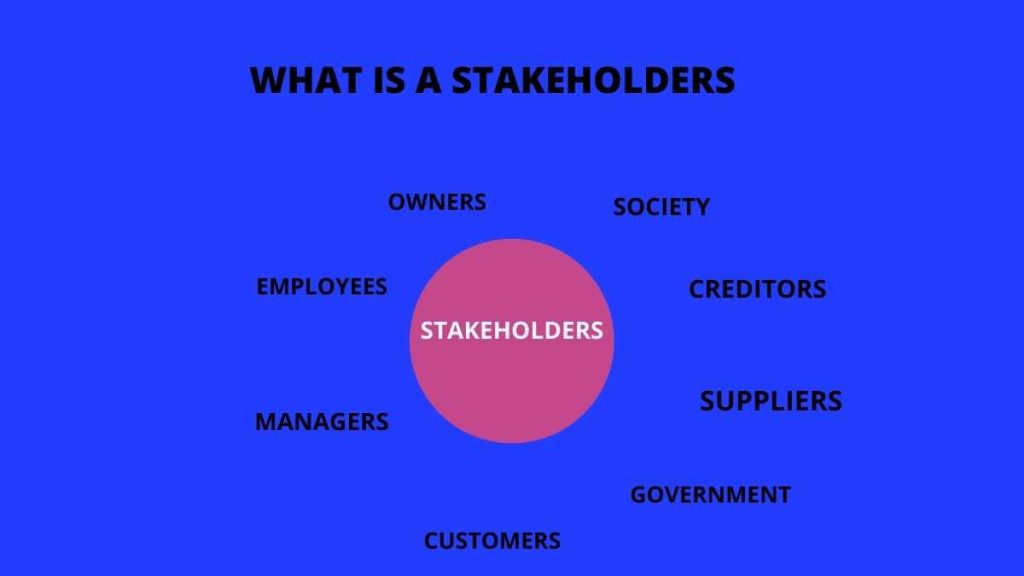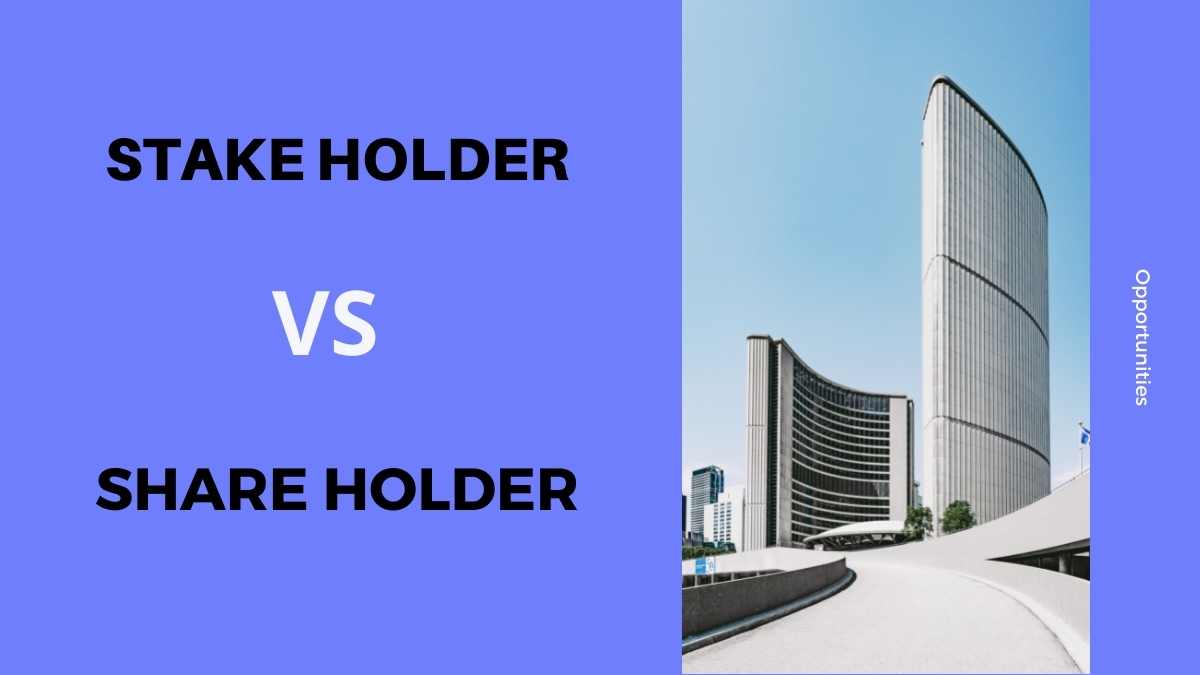The business world, stakeholder and shareholder, are often used interchangeably. Taking a closer look at stakeholder vs shareholder, there are some key differences.” Shareholders are generally stakeholders of a company, but not necessarily shareholders. A shareholder owns equity stock in a company and thus holds ownership stakes in it”.
On the other hand, a stakeholder is interested in the company’s performance for reasons other than capital appreciation. Both the terms “shareholders” and “stakeholders” have similar sounds, but their meanings are very different.
READ ALSO: Zero investment business Ideas
Key Takeaways
They have direct contact with the company. External stakeholders include suppliers, distributors, and community members.
- Profitability and share price are the primary concerns of shareholders. Generally, stakeholders are concerned about the health of the company.
- If a shareholder ceases to own shares in a company, their interest ceases. On the other hand, stakeholders have a more long-term interest in a company because their ties are far more complex and difficult to break.
What is a Shareholder?
- Shareholders can be individuals, companies, or institutions that own shares in a company and have a financial stake in its success. The shareholders of a company may be individual investors or large corporations with a stake in the company.
- The shareholder’s value increases if the company’s stock price rises, whereas the shareholder’s value decreases if the company’s stock price drops.
- In order to improve the company’s financial position and increase the share price and dividends, shareholders would like the management to take actions that improve the share price and dividends. Investors are individuals or institutions who own shares in a company.
- A shareholder in a company is considered a partial owner since they own a share. Whenever the company makes a profit from the market, they receive dividends in the form of monetary benefits.
- Its shareholders do not manage a firm’s operations. Its shareholders appoint directors to conduct the operations.
Liquid Investments
Shareholders typically own liquid investments in companies that can be liquidated for a profit. Most investors purchase a portion of a company’s shares in the hope that the shares will increase in value so they can earn a higher return on their investment. Part or all of a shareholder’s shares in a company can be sold, and the money may be used to purchase shares in another company or to make a totally different investment.
Liability for the Company’s Debts
Shareholders own the company; they are not responsible for its debts or other financial obligations. The shareholders cannot be held responsible. In private companies, partnerships, and sole proprietorships, creditors have the right to demand payments and auction properties owned by owners of these entities.
Rights of a Shareholder
- Owners of the company have certain rights even though they do not participate in its day-to-day operations. This is stipulated in the company’s charter. Inspecting the company’s books and financial records for the year is one of these rights.
- There is a right for shareholders to have access to financial records if they are concerned about the company’s top executives. Shareholders can sue the company directors and executives if they find anything unusual in the financial records. However, they receive their share of the proceeds after creditors, and preferred shareholders have been paid.
- An investor is an individual or an organization that owns shares in a publicly-traded or privately held company and thus is interested in its profitability. Shareholders can receive dividends, vote on corporate policy or amendments, or elect a board of directors based on the type of share they own.
- The decisions of shareholders can affect the direction a company takes, such as in mergers and acquisitions, but shareholders are not responsible for the company’s debts. Stockholders, also known as shareholders, typically fall into the following categories:
Preferred shareholder:
Typically, preferred stockholders are not allowed to vote, so they cannot influence the company’s future. However, they receive a guaranteed annual dividend payment (except under certain circumstances).
Common shareholder:
Dividends on common stock are variable, not guaranteed, and determined by the board of directors. In the event that a company’s assets need to be liquidated, common stockholders are the last to receive payment, after creditors and preferred stockholders. Common stocks are more popular than preferred stocks. However, unlike preferred shareholders, they have voting rights, which gives them some control over management decisions and corporate policy.
What is a stakeholder?
- Stakeholders are interested in the success or failure of the company. The objectives and policies of a company may affect or be affected by a stakeholder.
- It is possible for stakeholders to be internal or external. Stakeholders within the company are directly involved either through employment, ownership, or investing.
- Employees, shareholders, and managers are examples of internal stakeholders. Furthermore, external stakeholders are groups outside of the company that may be affected by the company’s actions but do not have a direct relationship with it. These groups include suppliers, creditors, community organizations, and government agencies.
- An organization’s stakeholders are individuals, organizations, or groups that have an active interest in its functioning. Changes in the business can affect or are affected by stakeholders. There are two types of stakeholders: internal and external. In the context of a company, internal stakeholders are people with interest in it due to a direct relationship with it, such as ownership, employment, or an investor.
- A stakeholder is a person who is impacted by its actions or business outcomes, though not directly involved with a company. External stakeholders include creditors, suppliers, and public groups.

Stakeholder performance affect
Its performance directly or indirectly affects them. Examples of stakeholders include:
- If the company goes bankrupt, employees lose their jobs
- If the company ceases to operate, customers cannot access its products or services
- And providers lose a reliable source of revenue
- The lenders who lose money if the company defaults on its financial obligations
- Shareholders lose money if the company goes out of business
The community and society, in general, are also stakeholders. Therefore, if you run a manufacturing business, you have to think about the needs of neighboring communities – specifically, how your operations impact their livelihood and quality of life. A stakeholder can be internal or external:
A company’s internal stakeholder is any individual or entity that has a direct relationship with the company.
Examples: Owners, employees, investors, managers, board members, etc.,
External stakeholder:
An individual or organization that is not directly affiliated with the company but is nevertheless affected by its decisions and actions. Customers, end users, creditors, suppliers, local communities, society at large, and government regulators are examples.
Stakeholders in project management include the following:
| Executive committee | Project sponsor |
| Project leaders (e.g., project manager or scrum master) | Team members |
| Functional managers | Project consultants |
| Contractors | Customers |
| End users |
Lifespan
Longevity is one of the characteristics of shareholders in a company. Stakeholders cannot easily remove their stakes from the company. Stakeholders and the company are dependent on each other for a variety of reasons. In the event that the company’s performance declines, it presents a significant issue for all stakeholders.
Example,
Employees will lose their jobs if the company’s operations are ended, and they will no longer receive regular paychecks to support their families. Additionally, suppliers will no longer supply the company with essential raw materials and products, resulting in a loss of income and the suppliers having to find new markets for their products.
Stakeholder vs Shareholder Corporate Social Responsibility
Company shareholders were traditionally the only ones responsible for the company’s performance. In recent years, however, this has changed. Corporations have begun to accept the fact that, apart from shareholders, they are also accountable to a number of other constituents within the business sphere.
Example:
Suppose a company engages in business activities that take away green space from a community. In that case, it must develop programs that protect both the community’s social welfare and the ecosystem. The company may plant trees, provide clean drinking water to the community, and provide scholarships to members of the community.
Viewpoints of Stakeholders vs. Shareholders
Shareholders and stakeholders have different viewpoints depending on their interests in the company.
It is in shareholders’ interests for top executives to perform well in the company so that their actions impact stock prices and dividend distributions. Furthermore, shareholders will want the company to focus on expansion, acquisitions, mergers, and other activities that will increase the company’s profitability and overall health. Stakeholders, on the other hand, are concerned about longevity and quality of service.
Example:
A higher profit may not be as important to the company’s employees as better salaries and wages.
Additional Resources
CFI offers the Financial Modeling & Valuation Analyst (FMVA)TM certification program for those looking to advance their careers. Following are CFI resources you can use to keep learning and advancing your career:
- Structure of capital
- Corporate structure
- Share capital
- Shareholder primacy
Financial Analyst Training
CFI’s online certified financial analyst training program offers world-class financial training!
Stakeholder vs. shareholder Differeces
| Stakeholders | Shareholders |
| Meaning Stakeholders are individuals or organizations who are directly interested in the operations of a business. | Meaning Shareholders are individuals or organizations that own shares of a company. |
| Impact A company’s events can directly or indirectly affect stakeholders | Impact An organization’s shareholders are always directly affected by its events |
| Roles A company’s stakeholders cannot be shareholders | Roles Shareholders in a company are stakeholders |
| Monetary Benefit Some stakeholders do not receive monetary compensation | Monetary Benefit Each shareholder receives a monetary benefit |
| Types Employees, creditors, government, suppliers, and customers are among the possible types of clients | Types The two types of shareholders are equity shareholders and preference shareholders. |
| Focus Area Performance of the company | Focus Area Return on investment (ROI) is a major focus |
Shareholder Theory vs. Stakeholder Theory
Shareholders’ and stakeholders’ interests do not always align. In fact, they can be at odds with one another. Therefore, shareholders might want a company to outsource production overseas or use a different supplier in order to increase profits, but stakeholders might favor maintaining production for reasons of quality control, avoiding supply-chain disputes, or for other reasons.
“Corporations can play a critical role in improving society when CEOs truly commit to meeting the needs of all stakeholders.”
Stakeholder vs. shareholder: Main points
Let’s compare and contrast the two more closely to highlight the differences between them.
1. Company ownership
An individual or entity with a majority ownership stake in a company owns at least 50% of its outstanding shares. The founders of the company or their descendants usually hold these positions.
Stakeholders aren’t necessarily shareholders, but they are interested – their stake – in the business. Shareholders can also own shares in the company, as in the case of employee-shareholders.
2. Priorities
Investors are primarily interested in the financial returns on their investments, whether through dividends or stock appreciation. Among other things, stakeholders evaluate the company’s performance, how it treats customers, partners, and employees, and its impact on the community.
3. Long-term vs. short-term need
Stockholders can do whatever they want with their shares – they can sell them and buy them from another company, even if it’s a competitor. Essentially, they may be financially invested in the company, but its overall success isn’t always their main concern.
The majority of stakeholders are in it for the long run, not just for stock performance. They desire that a company succeeds, not just in terms of stock performance.
4. Categorization
Stakeholders are a broader category than shareholders. Shareholders are always stakeholders, but stakeholders aren’t always shareholders.
Furthermore, only companies that issue shares have shareholders, whereas every organization, big or small, regardless of their industry, has stakeholders.
FAQs
Are employees shareholders or stakeholders?
A company’s internal stakeholders are its employees, executives, and board members because they have a direct relationship with the company. External stakeholders include suppliers, distributors, and community members. A company’s profitability and share price are most important to shareholders.
Is a stakeholder the same as an investor?
A stakeholder is a person or an organization that has a legitimate interest in the outcome of a situation, action, or venture. As opposed to an investor who contributes money to a project with the hope of making a profit, a stakeholder is only required to have a legitimate interest in it.
How do you determine the key stakeholders?
An organization’s actions, objectives, and policies can affect or be affected by stakeholders. In addition to creditors, directors, employees, the government (or its agencies), shareholders, vendors, unions, and the community in which the business operates are examples of key stakeholders.
Who are the plants’ stakeholders?
A company’s business operation can have an impact on a plant’s reproduction and survival, making it a stakeholder. For example, plants are a primary non-social stakeholder within a flower company.
What are the four ways of managing change with stakeholders?
Here are four ways to manage stakeholders proactively
1. Sustain their position.
2. Change their attitude.
3. Activate their help potential.
4. Reduce their harm potential.
Who are shareholders?
An owner of stock in a company is referred to as a shareholder. Shareholders can own as few as one share. Dividends and capital gains (or losses) are retained by shareholders as residual claims on a firm’s profits.


